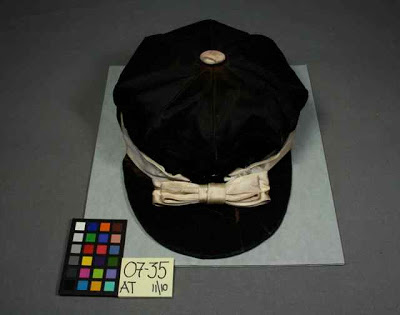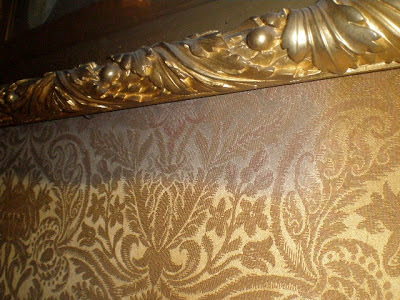Over the years SAC has had many museum clients. Each Museum, whether they are about history, art, music, culture, science, you name it - EVERYONE has storage needs. While each museum is different, one thing is always the same in our treatments: in all cases we have incorporated the proper rehousing of each artifact in the treatment. Why is rehousing so crucial to treatment? Because the method of treatment or the display choice, is directly affected by storage situations or constraints.
The "unexhibited" collections of a museum can far exceed what is visible to the public on a daily basis. And many items in storage are "unexhibitable" because of the way they have been stored or housed. A common factor in the storage of textiles is the standard sized garment box. At just 18 inches wide and various lengths, a regular sized garment, whether it be a jacket, dress, or trousers, is simply too wide to fit inside without getting scrunched. (Scrunching = wrinkles, distortion and stress on already fragile fabric). So why not just get a bigger box? Because this is the standard-size commercially produced archival box, and the chance that boxes everywhere will be reconfigured is pretty slim. Moreover, making custom boxes is very costly.
The next factor in contributing to "unexhibitable" artifacts is acid-free tissue paper. It helps to soften creases in textiles, and is almost universally used in all museums. Quite frankly, I wish it was not. Not only is it not as effective as it needs to be, but it is almost not-reusable, it shifts, it settles, it is not reliable for support. See the photos of two similar caps below.
 |
| A cap before treatment with acid-free tissue as support |
 |
| A cap with ethafoam/stockinette batting support. Fully supported, acid-free and no trees harmed. |
Let me give you the best example I have: A museum with a huge collection of textiles, a limited amount of storage, and a huge need for stable storage of these textiles.
Such a museum is the Harness Racing Museum and Hall of Fame. SAC has treated many of their historic silk jackets and caps. Their textiles are somewhat unique in that many were heavily worn and used excessively. In fact, one jacket had soil and rocks from the race track embedded within the hem of the jacket. So much was present, and it was so tightly packed, that the museum decided to keep the dirt in place to demonstrate the closeness of the rider to the horse and track. Some jackets however had suffered from exposure of light damage during previous museum display. And many simply had the combination of both modes of deterioration.
 |
| Harness racer in his racing silks. |
The treatment of the silks have required the stabilization of the silk fabric itself. For caps, the brim boards are at times broken with the silk wrapping fragmented (see image below).
Due to the fragility of the artifacts, they need to be fully supported. In garments, SAC does this by creating an internal pillow which is made of needle-punch batting and stockinette for the body and each of the arms. In this way the form of the body is created, which significantly reduces creases. In addition, a smooth polyester fabric sling is created that wraps around the jacket while it is in the acid-free box (see photos of jacket below). Hats receive a similar treatment, detailed below.
 |
| Cap after treatment with internal support |
 |
| Treated jacket with internal support inside its new storage box with polyester fabric sling. |
Full support is not just beneficial for garments. Hats and caps are perfectly suited for the same kind of treatment, and perhaps even more so. The internal structure for the caps are made with a disc of Ethafoam and polyester batting covered with stockinette. Below left, the unsupported hat is shown next to its custom made internal support. The image is clear, without proper support, the treatment is not complete.
 |
| Cap, without internal support (left), is flat and without structure. Its custom made internal support (right) provides the internal support to the fragile silk. |
 |
| The storage of two caps, "double-decker" style, using a standard size archival box. |
In an earlier post, we discussed the custom storage and display with the treatment of a unique artifact. But this is a little different; in this case, many of the artifacts are quite similar. So, a systematic solution needs to be determined that both works with the full range within the genre, but also is similarly able to adapt to small variations while also being supportive and similar to researchers or those who are accessing the collection. A solution from SAC is the "double decker" hat storage (see image above). Two hats are fully supported in an acid-free environment. It takes up less space and you do not have to disturb one to access the other. They are however paired together because they are likely to be accessed together.
So we can change the way things are stored, but changing storage space is more difficult. Museums are limited by their physical space. Shelving is standard and objects and their boxes are not. But some items need to be stored together simply because they belong together.
This is a common feature with any specialty collection, whether it be an isolated collection among others in a museum, or a focused museum like the Harness Museum, all museums have large groups of similar artifacts that are best stored in a similar manner that assists with everyone who accesses the collection. Determining what system to put in place is based on several factors. To begin, several questions must be asked: what is the size of the actual artifact in the group, the amount of use by researchers or others, fragility or sensitivity of the material(s), how are other collections stored, and what space is available for the actual storage.
Visit the Spicer Art Conservation website to see more about the treated items at the Harness Racing Museum. Visit the Harness Racing Museums website here: www.harness.org and go see them if you can. They were awarded the AIC/Heritage Preservation Ross Merrill award for outstanding commitment to the preservation and care of collections for 2012.
_____________________________
Gwen Spicer is a textile conservator in private practice. Spicer Art Conservation specializes in textile conservation, object conservation, and the conservation of works on paper. Gwen's innovative treatment and mounting of flags and textiles is unrivaled. To contact her, please visit her website.












